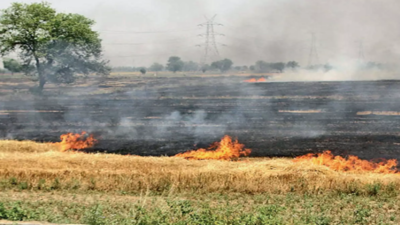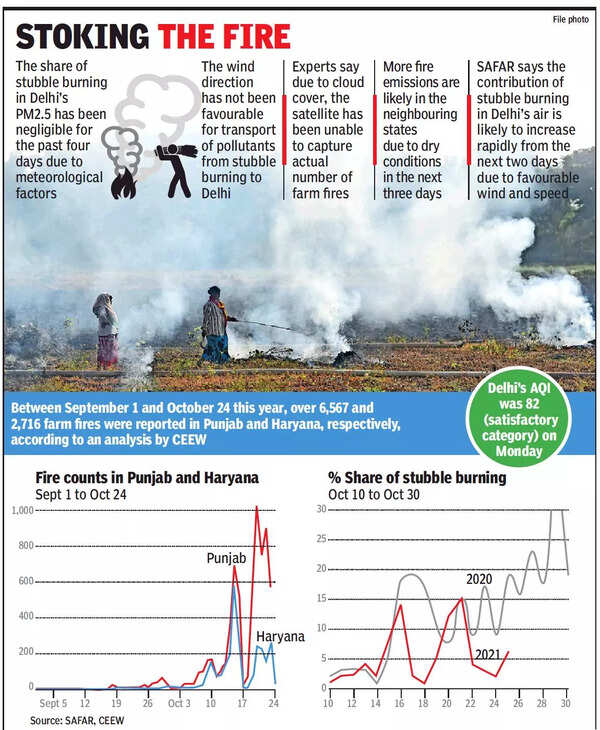- News
- City News
- delhi News
- Stubborn stubble: Delhi’s agony set to return
Trending
This story is from October 26, 2021
Stubborn stubble: Delhi’s agony set to return
The emission from harvest remnant burning in the PM2.5 pollutants in Delhi’s air has been negligible for the past four days due to meteorological factors. However, the farm fires are likely to increase and stubble burning is expected to impact Delhi’s air quality rapidly from October 27. The ‘satisfactory’ air after Sunday’s rain is, in that regard, a short-lived respite for Delhiites.

Farm fires may start impacting air rapidly from tomorrow
NEW DELHI: The emission from harvest remnant burning in the PM2.5 pollutants in Delhi’s air has been negligible for the past four days due to meteorological factors. However, the farm fires are likely to increase and stubble burning is expected to impact Delhi’s air quality rapidly from October 27. The ‘satisfactory’ air after Sunday’s rain is, in that regard, a short-lived respite for Delhiites.
Track the pollution level in your city
System of Air Quality and Weather Forecasting and Research (SAFAR), the Union earth sciences ministry’s forecasting body, foresees more stubble fires in the coming days.Gufran Beig, founder and project director, SAFAR, said, “Due to rain and cloud cover, satellites haven’t been able to capture with accuracy the incidence of farm fires. For instance, just 127 farm fires were spotted in the last 24 hours when the fire emission proportion in Delhi’s PM2.5 was 6%.”

SAFAR added that with transport level winds blowing in from Punjab and Haryana, enhancing the intrusion likelihood in terms of speed and direction and no likelihood of rainfall, the impact of farm fires in Delhi's AQI was likely to be increasing rapidly from October 27. While the AQI was 82 in the ‘satisfactory’ category on Monday, SAFAR predicts the index on October 27 and 28 to be in the high end of ‘poor’ category or the lower end of ‘very poor’ category.
L S Kurinji, programme associate, Council on Energy, Environment and Water, added that between September 1 and October 24, over 6,567 fire were reported in Punjab and 2,716 in Haryana. Kurinji said, “The share of stubble burning in Delhi’s PM2.5, however, remained less than 5% for the past three days due to southwesterly winds. The rain on Sunday also brought down the particulate levels to below the permissible limits of 60 microgramme per cubic metre. For the next two days, predicted northwesterly winds may support the movement of smoke from the neighbouring states to Delhi-NCR.”
Tanushree Ganguly, programme lead, CEEW, felt that action had to be taken against year-round sources of pollution in Delhi, including transport, road and construction dust and disposal of municipal waste. “Delhi government must use insights from the newly developed Decision Support System in its planning and preventive and responsive measures," she said.
Track the pollution level in your city
System of Air Quality and Weather Forecasting and Research (SAFAR), the Union earth sciences ministry’s forecasting body, foresees more stubble fires in the coming days.Gufran Beig, founder and project director, SAFAR, said, “Due to rain and cloud cover, satellites haven’t been able to capture with accuracy the incidence of farm fires. For instance, just 127 farm fires were spotted in the last 24 hours when the fire emission proportion in Delhi’s PM2.5 was 6%.”

In its bulletin on Monday, SAFAR forecast, “More fire emission is likely due to dry conditions over the next three days in the upwind, northwest region. Due to this, PM2.5 will increase. The effective fire counts observed in the last 24 hours are just 127 and their contribution in Delhi's PM2.5 is 6%. However, as satellites highly underestimate the counts during cloudy and rainy periods, actual counts might be much higher.”
SAFAR added that with transport level winds blowing in from Punjab and Haryana, enhancing the intrusion likelihood in terms of speed and direction and no likelihood of rainfall, the impact of farm fires in Delhi's AQI was likely to be increasing rapidly from October 27. While the AQI was 82 in the ‘satisfactory’ category on Monday, SAFAR predicts the index on October 27 and 28 to be in the high end of ‘poor’ category or the lower end of ‘very poor’ category.
L S Kurinji, programme associate, Council on Energy, Environment and Water, added that between September 1 and October 24, over 6,567 fire were reported in Punjab and 2,716 in Haryana. Kurinji said, “The share of stubble burning in Delhi’s PM2.5, however, remained less than 5% for the past three days due to southwesterly winds. The rain on Sunday also brought down the particulate levels to below the permissible limits of 60 microgramme per cubic metre. For the next two days, predicted northwesterly winds may support the movement of smoke from the neighbouring states to Delhi-NCR.”
Tanushree Ganguly, programme lead, CEEW, felt that action had to be taken against year-round sources of pollution in Delhi, including transport, road and construction dust and disposal of municipal waste. “Delhi government must use insights from the newly developed Decision Support System in its planning and preventive and responsive measures," she said.
Smog season: 5 ways surrounding states are behind Delhi’s winter pollution
End of Article
FOLLOW US ON SOCIAL MEDIA










